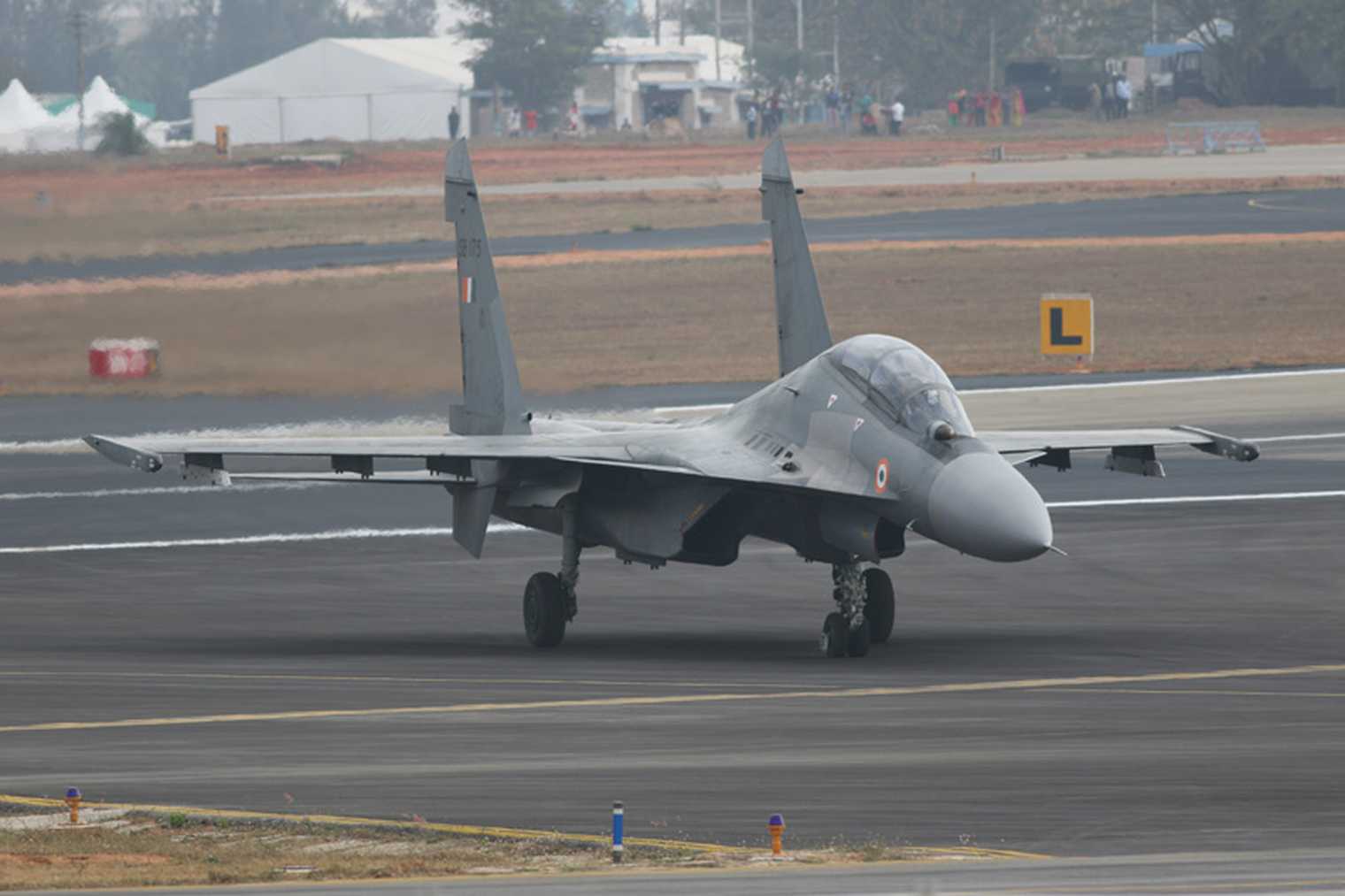(DEFENCE SECURITY ASIA) — In a landmark geopolitical development, Tajikistan has reclaimed full control of the Ayni Air Base, bringing to an end India’s nearly two-decade operational presence at the strategically vital facility.
This decisive move, concluded in October 2025, marks a significant inflection point in Central Asian geopolitics, as Russia and China intensify their grip over regional military and political spheres of influence.
India Air Force fighter aircraft
**For New Delhi, the loss of Ayni Air Base is not merely a logistical setback—it represents a profound contraction of its strategic reach in a region crucial for monitoring Pakistan, Afghanistan, a…
(DEFENCE SECURITY ASIA) — In a landmark geopolitical development, Tajikistan has reclaimed full control of the Ayni Air Base, bringing to an end India’s nearly two-decade operational presence at the strategically vital facility.
This decisive move, concluded in October 2025, marks a significant inflection point in Central Asian geopolitics, as Russia and China intensify their grip over regional military and political spheres of influence.
India Air Force fighter aircraft
For New Delhi, the loss of Ayni Air Base is not merely a logistical setback—it represents a profound contraction of its strategic reach in a region crucial for monitoring Pakistan, Afghanistan, and the broader Eurasian security theatre.
As great-power competition deepens, Tajikistan’s action underscores the precarious balancing act faced by smaller states caught between rival nuclear-armed powers and the strategic ambitions of regional giants.
Located roughly 15 kilometers west of Dushanbe, the Ayni Air Base—also known as Farkhor-Ayni complex—has its roots in the Soviet era.
Constructed during the Cold War, Ayni was a linchpin in the Soviet Union’s military architecture, supporting operations across the Pamir Mountains and sustaining the USSR’s invasion of Afghanistan from 1979 to 1989.
After the dissolution of the Soviet Union in 1991, Tajikistan inherited the facility but lacked the economic means and stability to maintain it amid the devastating civil war that ravaged the nation through the 1990s.
India’s involvement began in the early 2000s, at the height of the global war on terror.
In 2002, New Delhi and Dushanbe signed a bilateral agreement to renovate and jointly operate the base, which became India’s first and only overseas military installation.
India reportedly invested between USD 70 million and USD 100 million (approximately RM 330 million to RM 470 million) to modernize the airbase, extending its runway to 3,200 meters, constructing new hangars, air traffic control towers, radar facilities, and perimeter fortifications.
The upgrades allowed the base to accommodate Su-30MKI multi-role fighters and Mi-17 helicopters, along with an estimated 200 Indian Air Force (IAF) and Army personnel overseeing maintenance and logistics.
Strategically, Ayni provided India a rare vantage point in Central Asia—less than 1,000 kilometers from Pakistan’s northern border and within surveillance reach of Afghanistan’s Wakhan Corridor.
This proximity made the base an ideal hub for intelligence, humanitarian operations, and counterterrorism coordination, while subtly reinforcing India’s posture against Pakistan’s influence in the region.
The Ayni-Farkhor complex also symbolized India’s “soft entry” into Central Asian security affairs, serving as a logistical backbone for supporting the Northern Alliance during the pre-Taliban Afghan era.
Notably, Ahmad Shah Massoud, the famed anti-Taliban commander, was treated in India’s field hospital at Farkhor after an assassination attempt in 2001—a symbolic testament to the facility’s strategic and humanitarian role.
India’s Strategic Imperatives in Central Asia
For New Delhi, Ayni was more than a forward operating base—it was a strategic fulcrum anchoring India’s geopolitical outreach into Eurasia.
Its location provided a unique dual advantage: a military platform to project airpower beyond South Asia, and a listening post to monitor the volatile Afghanistan-Pakistan frontier.
In the aftermath of the 1999 Kargil War, India recognized the need for forward intelligence and early-warning outposts beyond its borders.
Ayni filled that void, allowing Indian surveillance aircraft and intelligence operatives to track Taliban movements and regional militancy in Afghanistan’s Badakhshan province.
In hypothetical wartime contingencies, the airbase could have served as a staging ground for Indian Air Force strikes deep inside Pakistan, including potential operations targeting Peshawar or Abbottabad, thereby stretching Islamabad’s defense posture.
Beyond the military calculus, Ayni fit into India’s “Connect Central Asia” policy unveiled in 2012, a framework aimed at deepening economic, energy, and security ties with the region.
Through projects like the International North-South Transport Corridor (INSTC) and Chabahar Port in Iran, India sought to bypass Pakistan’s chokehold on continental access routes, establishing a network of land and maritime logistics corridors extending from the Indian Ocean to the Caspian Sea.
Yet, despite the ambitions, India’s presence at Ayni was based on a lease arrangement rather than outright sovereignty—an arrangement that made its continued operation vulnerable to political shifts in Dushanbe and to the external pressures exerted by Moscow and Beijing.
Unlike U.S. or Russian basing strategies, which often involve long-term leases and mutual defense clauses, India’s model relied on diplomatic goodwill and limited operational autonomy.
This cautious, quasi-diplomatic approach reflected India’s attempt to project influence without provoking regional sensitivities.
However, such a model left Ayni exposed to the changing tides of Eurasian geopolitics.
 Indian Sukhoi Su-30MKI
Indian Sukhoi Su-30MKI
Russia and China: The Pressure Campaign Behind the Withdrawal
India’s exit from Ayni was not a mere expiration of lease terms—it was the culmination of coordinated strategic pressure from both Russia and China, the twin power brokers of Central Asia.
By 2021, Tajikistan had notified India that the lease would not be renewed beyond 2022.
Behind the scenes, Moscow and Beijing reportedly pressured Dushanbe to prioritize “regional security cohesion” under their respective spheres of influence.
For Russia, the presence of an Indian military facility—especially one outside the Collective Security Treaty Organization (CSTO) framework—was increasingly viewed as incongruent with its regional command structure.
Russia maintains over 7,000 troops in Tajikistan through its 201st Motor Rifle Division, the largest permanent deployment of Russian forces abroad.
As Tajikistan’s principal security guarantor, Moscow has leveraged its military presence to deter cross-border infiltration from Afghanistan while maintaining dominance over Central Asian defense policy.
Following its 2022 invasion of Ukraine, Moscow’s reliance on China intensified, reshaping the strategic calculus of Eurasian diplomacy.
Reports indicate that Russia viewed India’s independent base in Tajikistan as an obstacle to its efforts to reassert exclusive strategic control over the CSTO zone, and thus quietly urged its removal under the guise of “regional realignment.”
China, too, exerted parallel leverage.
Bordering Tajikistan via the Xinjiang Uyghur Autonomous Region, Beijing has invested billions of dollars in security and infrastructure projects through the Belt and Road Initiative (BRI), including constructing military outposts near the Wakhan Corridor.
From China’s perspective, an Indian-operated airbase within 20 kilometers of its sensitive western frontier represented a latent surveillance risk.
Beijing’s economic tools—infrastructure loans, border security assistance, and debt leverage—gave it the capacity to nudge Dushanbe toward compliance.
With Tajikistan’s external debt to China surpassing USD 3 billion (about RM 14.1 billion), and with remittances from Russia forming nearly 30 percent of its GDP, Dushanbe’s autonomy in foreign policy was severely constrained.
Under such circumstances, the decision to terminate India’s access to Ayni was almost preordained.
The Geopolitical Fallout: India’s Strategic Vacuum in Central Asia
India’s withdrawal from Ayni by October 2025 marks a profound reduction in its forward military presence beyond South Asia.
The IAF reportedly dismantled its Mi-17 helicopter detachment, maintenance hangars, radar arrays, and logistics centers, ensuring no sensitive technologies were left behind.
Officially, both India and Tajikistan described the move as a “lease conclusion,” but the timing and coordination with Moscow’s broader regional posture betray deeper strategic motivations.
For New Delhi, the loss of Ayni represents the collapse of its only physical foothold in Central Asia—a region pivotal to its counterterrorism, intelligence, and anti-Pakistan contingencies.
The departure also undermines India’s aspirations for a sustained continental influence, coming just as Beijing expands its military logistics network across Kyrgyzstan and Tajikistan.
Domestically, Indian opposition parties have criticized the development as a “strategic failure of diplomacy”, arguing that the government underestimated the extent of Sino-Russian coordination in reconfiguring Central Asia’s geopolitical map.
Meanwhile, Tajikistan, though now asserting sovereignty over Ayni, faces an increasingly tight strategic embrace by Moscow and Beijing.
By relinquishing India’s presence, Dushanbe may have reinforced its autonomy on paper but deepened its dependence in practice, trading one partnership for two more dominant patrons.
This pattern mirrors the wider “multi-vector diplomacy paradox” of Central Asia—where smaller states outwardly balance between powers but often succumb to the economic gravity and military coercion of regional giants.
The impact extends to regional institutions like the Shanghai Cooperation Organization (SCO), of which India, China, Russia, and Tajikistan are all members.
Ayni’s closure exposes fault lines in the Russia-India-China (RIC) framework, a once-idealized trilateral platform now fractured by border disputes and divergent strategic aims.
Strategic Repercussions and Future Adaptations
With Ayni lost, India faces the urgent need to restructure its Central Asia strategy.
Military analysts suggest New Delhi may pivot toward dual-use partnerships and rotational access agreements with Kazakhstan and Uzbekistan, whose governments maintain relatively neutral stances between Moscow and Beijing.
Alternatively, India could amplify its presence in the Persian Gulf and the Indian Ocean, leveraging Chabahar Port and the INSTC to sustain strategic mobility across Eurasia through trade and logistics rather than physical basing.
The Indian military is also expected to increase aerial surveillance along the northern sector, potentially through the deployment of long-endurance UAVs like the Heron TP and indigenous Ghatak stealth drone, to compensate for the loss of its forward base.
From a defense-industrial perspective, India may accelerate joint projects with Russia—such as Su-30MKI upgrades, S-400 deliveries, and BrahMos exports—to preserve influence despite diminishing on-ground access.
However, Moscow’s alignment with Beijing increasingly complicates India’s calculations, limiting the reliability of the Russia-India defense axis that once underpinned its regional outreach.
For Russia and China, Tajikistan’s “reclamation” of Ayni is both a symbolic and strategic victory.
It validates their combined ability to exclude external military actors from Central Asia, an area they regard as a geopolitical buffer zone protecting their respective borders.
Analysts warn that this success could embolden future joint actions to curtail Western or non-aligned presences in the region, possibly targeting U.S. logistics agreements with Uzbekistan or Turkmenistan next.
Tajikistan itself, under President Emomali Rahmon, must tread carefully.
While the regime enjoys enhanced backing from both Moscow and Beijing, it faces mounting domestic challenges—ranging from poverty and youth unemployment to extremist recruitment along its Afghan frontier.
Rahmon’s government may seek renewed aid diversification through the European Union, Iran, and the Gulf States to offset overreliance on Russian security and Chinese finance.
** A Strategic Lesson in the Shadow of the Pamirs**
The reclamation of Ayni Air Base marks more than the end of an Indian lease—it encapsulates a profound shift in the strategic geometry of Central Asia.
What began as India’s bold step into Eurasia two decades ago has ended as a case study in the limits of medium-power projection under the weight of great-power realignment.
The episode underscores a harsh truth: in the high-altitude shadow of the Pamir Mountains, sovereignty and alignment are fluid commodities, traded amid pressure, debt, and coercive diplomacy.
For India, Ayni’s loss is both a symbolic retreat and a strategic wake-up call, highlighting the necessity to innovate beyond traditional basing models.
For Tajikistan, it reaffirms sovereignty at the cost of independence, binding its future to the twin orbits of Moscow and Beijing.
And for Russia and China, the episode is a triumph of coordinated regional dominance, reinforcing their hold over Central Asia as the new Eurasian order solidifies in the post-Afghanistan and post-Ukraine landscape.
As global power rivalries sharpen, the story of Ayni Air Base stands as a reminder that in Central Asia’s vast chessboard, control of a runway can alter the trajectory of a nation’s strategic destiny. — DEFENCE SECURITY ASIA
